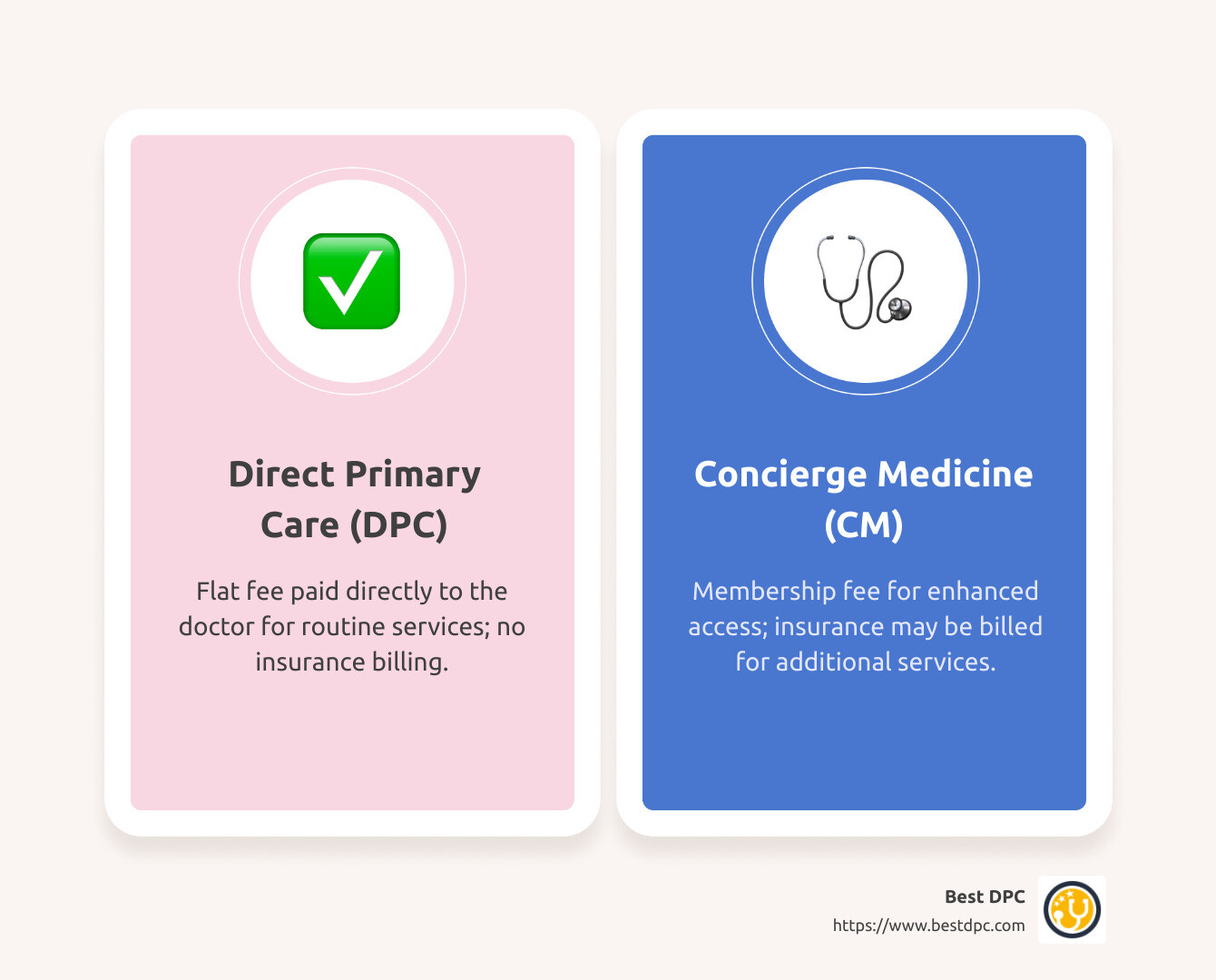Wayne Lowry

What is the difference between direct primary care and concierge medicine? If you’re curious about this question, here’s a quick answer:
Both models focus on personalized healthcare and improved patient engagement.
In today’s healthcare world, many people seek more personalized experiences with their doctors. Feeling rushed in a typical doctor’s office is common because conventional practices handle large patient loads. This pressure often limits the time doctors spend with each patient, leaving many longing for more attentive care.
This is where healthcare models like Direct Primary Care (DPC) and Concierge Medicine (CM) come into play. They offer an alternative by focusing on better patient-doctor connections. By utilizing these models, patients can enjoy longer appointments, easier communication with their doctor, and even the rare experience of house calls.
Choosing between DPC and CM depends on your personal needs and budget. DPC tends to be more cost-effective, while CM comes with a broader range of services. Both prioritize spending quality time with patients over dealing with insurance paperwork.

Understanding Direct Primary Care
Direct Primary Care Explained
Direct Primary Care (DPC) is a healthcare model that puts patients first by removing the complexities of insurance. Instead of dealing with insurance companies, patients pay a flat monthly or annual fee directly to their doctor. This fee covers a wide range of primary care services.
Financial Model
DPC operates on a membership-based model. Think of it like a subscription service for your healthcare needs. Patients pay a predictable fee, which means no surprise bills or hidden costs. This approach ensures that the focus remains on delivering quality care rather than on billing and insurance paperwork.
Patient Focus
The main goal of DPC is to strengthen the relationship between doctors and patients. Because doctors aren’t overwhelmed with administrative tasks, they have more time to spend with each patient. Imagine having a doctor who knows your medical history well and can provide personalized care without being rushed. That’s what DPC aims to offer.
Insurance Independence
One of the standout features of DPC is its independence from insurance. By not billing insurance companies, DPC practices can significantly reduce administrative overhead. This means doctors can focus more on patient care rather than on coding and billing.
Membership-Based Model
In a DPC practice, patients enjoy the benefits of a flat monthly fee. This fee typically covers routine care, preventive screenings, and chronic care management. There are no co-pays, deductibles, or co-insurance fees to worry about. This model is designed to be transparent and straightforward, making healthcare more accessible and affordable.
In summary, Direct Primary Care is about simplifying healthcare. By focusing on a direct financial relationship with patients, it offers a more personalized and efficient healthcare experience. It’s an excellent choice for those who value strong patient-doctor relationships and want to avoid the hassles of insurance billing.
Cost and Accessibility of Direct Primary Care
Direct Primary Care Costs
Direct Primary Care (DPC) focuses on delivering affordable and accessible healthcare through a simple and transparent pricing model. This approach resonates with a diverse range of patients, making healthcare more predictable and easier to manage.

Affordability
DPC practices charge a flat monthly or annual fee—usually between $900 and $1,500 per year. This fee covers most primary care services, ensuring predictable pricing. Patients don’t have to worry about surprise bills or hidden charges. In fact, there are no co-pays, deductibles, or co-insurance fees involved.
This affordability makes DPC a great choice for many, including those who might not have comprehensive insurance coverage. It’s like having a subscription for your health, where you know exactly what you’re paying for each month.
Accessibility
DPC is designed to be accessible to everyone. By eliminating insurance billing, DPC cuts down on administrative overhead. This allows doctors to offer extended hours and telehealth options, making it easier for patients to get the care they need when they need it.
Patients can communicate directly with their doctors through phone, text, or email without the hassle of going through an insurance company. This direct line of communication helps in building a strong doctor-patient relationship, which is a key focus of DPC.
Patient Demographics
DPC serves a wide range of patients, from those with high-deductible health plans to families looking for comprehensive care. Many DPC practices offer family plans that cover parents and children under one membership, making it an ideal choice for families seeking affordable healthcare.
DPC is also a viable option for individuals in rural or low-income areas. The model emphasizes affordability, making it accessible to underserved populations who may struggle with traditional healthcare costs.
DPC is about making healthcare simple and predictable. By focusing on lower fees and transparent pricing, DPC ensures that patients from various demographics can access quality healthcare without financial stress.
Benefits and Drawbacks of Direct Primary Care
Benefits of Direct Primary Care
Personalized Care
Direct Primary Care (DPC) focuses on building strong patient-doctor relationships. With fewer patients to manage, doctors can spend more time with each individual. This means longer appointments where patients feel heard and their concerns are fully addressed. It’s like having a healthcare partner who knows you well and is invested in your long-term health.
Reduced Administrative Overhead
A significant benefit of DPC is the reduction in administrative tasks. By eliminating insurance billing, doctors can focus more on patient care rather than paperwork. This streamlining allows for better service quality and more time for preventive care, which is crucial for maintaining health and catching potential issues early.
Preventive Care Focus
DPC places a strong emphasis on preventive care. With regular check-ups and easy access to healthcare professionals, patients are encouraged to take proactive steps in managing their health. This focus can lead to better health outcomes and potentially lower overall healthcare costs in the long run.
Drawbacks of Direct Primary Care
Limited Specialty Care
While DPC excels in primary care, it may fall short when it comes to specialty services. Patients might need to seek additional care outside the DPC system for specialized treatments, which can lead to extra costs. Coordination with specialists is often necessary, and while DPC doctors can assist in this, it may involve additional out-of-pocket expenses.
Out-of-Pocket Costs
Although DPC offers a predictable pricing model, there can still be out-of-pocket costs for services not covered under the DPC membership. For example, hospital visits, specialist consultations, or advanced medical procedures may require separate payments. Patients need to be aware of these potential costs when considering DPC as their primary healthcare model.
Direct Primary Care offers a unique approach to healthcare that prioritizes personalized care and reduced administrative tasks. However, it’s important to weigh these benefits against the potential drawbacks, such as limited access to specialty care and additional out-of-pocket expenses.
Frequently Asked Questions about Direct Primary Care
What is the opposite of direct primary care?
The opposite of Direct Primary Care (DPC) is traditional fee-for-service healthcare. In this system, patients pay per visit or service, and insurance companies usually foot part of the bill. This insurance-centric approach often results in shorter doctor visits and increased paperwork for physicians as they handle billing and insurance claims.

Why do doctors switch to direct primary care?
Many doctors are drawn to DPC for a few key reasons:
Is direct primary care the same as concierge medicine?
While both DPC and concierge medicine emphasize personalized care, they are distinct models with different financial structures.
Both models share patient-centric values, but they cater to different needs and preferences. While DPC focuses on affordability and accessibility, concierge medicine offers a high-end healthcare experience.
Conclusion
Best DPC: Patient-Focused Care
Best DPC is dedicated to delivering a healthcare experience that prioritizes the patient above all else. By embracing the Direct Primary Care (DPC) model, Best DPC ensures that patients receive personalized attention without the distractions of insurance hassles. This approach allows doctors to focus on what truly matters—providing quality care and building strong patient-doctor relationships.
Affordability and Accessibility
One of the standout features of Best DPC is its commitment to affordability. With a flat monthly fee structure, patients can enjoy predictable healthcare costs without worrying about surprise bills. This transparency is a significant relief for many, making quality healthcare accessible to a broader range of individuals and families.
Moreover, Best DPC’s emphasis on accessibility means that patients can easily reach their healthcare providers. Whether through in-person visits, telemedicine, or direct communication channels, Best DPC ensures that help is always within reach. This approach not only improves health outcomes but also improves the overall patient experience.
When healthcare can often feel impersonal and complicated, Best DPC stands out by offering a straightforward, patient-centered solution. For those seeking affordable, accessible, and personalized care, Best DPC is a clear choice.
For more information on how Best DPC can meet your healthcare needs, visit Best DPC.


ABOUT AUTHOR
Wayne Lowry
Wayne Lowry, Founder of BestDPC, is a passionate advocate for Direct Primary Care (DPC) and its mission to deliver personalized, accessible healthcare. He believes that DPC providers should serve as the trusted first point of contact for all medical needs, ensuring patients never feel isolated or uncertain about their health decisions. Through his work, he champions a patient-first approach to healthcare, building a system that prioritizes guidance, support, and trust.

Thank You for Registering!
Your registration was successful! We're excited to have you on board. Please check your email for a confirmation link to complete your registration.